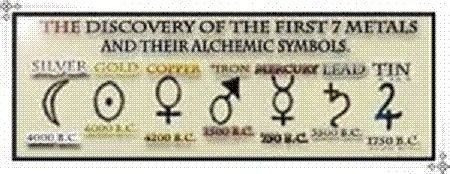 | ||
Metals of antiquity simplified
The metals of antiquity are the seven metals which humans had identified and found use for in prehistoric times. These elements, gold, silver, copper, tin, lead, iron, and mercury, are the metals from which the modern world was forged. Until the discovery of arsenic in the 13th century, these were the only known elemental metals, compared to the 86 known today.
Contents
Melting point
The metals of antiquity generally have low melting points, with iron being the obvious exception.
Extraction
While all the metals of antiquity but tin and lead occur natively, only gold and silver are commonly found as the native metal.
Rarity
While widely known during antiquity, these metals are by no means common. Of the 78 elements occurring naturally in the earth's crust in quantity (all the elements until bismuth, with the exceptions of the noble gases, technetium, and promethium, but also including thorium and uranium), with oxygen and silicon being the first two:
Yet all were known and available in tangible quantities in ancient times.
Symbolism
Each of the metals was associated with one of the seven then-known celestial bodies, and one of the seven days of the week.
